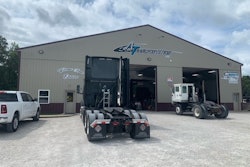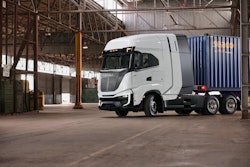Last quarter, big fleets started to really show damage from strong headwinds in the freight market, and this quarter has only been harsher. The results have been dramatic. Strongly negative double digit comps make up the norm on this list and one major player, Yellow, has completely called it quits.
That said, the rough market hasn't impacted all carriers the same, and some are showing bright spots and optimism even during one of the worst freight recessions in recent history.
Covenant's sheds hundreds of tractors
Covenant (CCJ Top 250, No. 38) saw its operating ratio creep up after recent acquisitions and a rough market. The fleet ended up reducing tractor count in an "intentional effort by management to adjust fleet size down in response to the reduced volumes of available freight with expedited service requirements." The dedicated segment also lost 217, or nearly 15% of its total tractors.
“The freight market, consisting of a combination of freight rates and volumes, remained challenging throughout the second quarter. While the 2023 results fall short of our 2022 results, we are pleased with the resiliency of our model in what we believe to be the trough of the freight cycle. We are also pleased with the initial operating results of Lew Thompson and Son Trucking, Inc.," Chairman and Chief Executive Officer, David R. Parker, commented.
Revenue: 2023 Q2: $274 million vs. 2022 Q2: $317.4 million
2023 YTD: $540.9 million vs 2022 YTD: $608.9 million
Income: 2023 Q2: $12.3 million vs. 2022 Q2: $24.5 million
2023 YTD: $28.9 million vs 2022 YTD: $46.7 million
–
Forward Air Corporation's brokerage, intermodal segments go nowhere
Forward Air Corporation (No. 50) saw revenue and income decline sharply from last year and last quarter, after forecasting a decline last quarter. The company did cite positive momentum in its LTL services and success in revenue growth strategies designed to win market share.
“Weaker-than-expected demand for our intermodal and truckload brokerage services resulted in" coming in below guidance ranges, Tom Schmitt, President and CEO of the company said. "Demand for intermodal and truckload brokerage capacity has been significantly impacted by the trough in the freight cycle. Furthermore, the challenging market conditions led to decreased customer demand for our accessorial services within the intermodal line of business."
Revenue: 2023 Q2: $402.2 million vs. 2022 Q2: $515.2 million
2023 YTD: $829.3 million vs. 2022 YTD: $982.2 million
Income: 2023 Q2: $30.2 million vs. 2022 Q2: $75.5 million
2023 YTD: $80.7 million vs. 2022 YTD: $132.9 million
[Related: Forward Air, Omni Logistics merge]
–
Heartland Express to step up ops after acquisitions
Heartland Express (No. 42), following a hot of a streak of acquisitions in 2022, saw revenues jump 63%, but instead of seeing $105.5 million in operating income on $187 million in revenue like they did in Q2 of 2022, they saw just $16.3 million income on $306 million in revenue. Company CEO Mike Gerdin reported a "general decline in freight volumes" in Q2 and "no meaningful movement in general freight demand."
Gerdin wrote it was "challenged with driving needed operational improvements at both CFI and Smith Transport given the current freight environment," but remained positive, saying he remains "confident that we can improve their respective operating ratios to align with our legacy Heartland Express operational expectations."
Revenue: 2023 Q2: $306.2 million vs. 2022 Q2 $187.8 million
2023 YTD: $637 million vs 2022 YTD: $339 million
Income: 2023 Q2: $16.2 million vs. 2022 Q2: $105.5 million
2023 YTD: $39.1 million vs 2022 YTD: $127.5 million
–
J.B. Hunt's Marketplace sees a drop in traffic
J.B. Hunt (No. 3) saw revenue drop 18%, as revenue per load dove 24% in Integrated Capacity Solutions and 13% in Intermodal. Additionally, total freight transactions in the Marketplace for J.B. Hunt 360 dropped 40%, from $556 million to $336. In Q1 of 2023, it had gone down 38%.
Revenue: 2023 Q2: $3.1 billion vs. 2022 Q2: $3.8 billion
2023 YTD: $6.3 billion vs 2022 YTD: $7.3 billion
Income: 2023 Q2: $270.7 million vs. 2022 Q2: $353.1 million
2023 YTD: $548.2 million vs 2022 YTD: $687.4 million
–
Knight-Swift Transportation takes a dip
Knight-Swift (No. 4) saw a 20.8% decrease in revenue over last year while income droped 71.1%. The company's acquisition of U.S. Xpress took effect on July 1, but not in time to turn things around in a down quarter.
David Jackson, CEO of Knight-Swift, commented, "The absence of typical seasonal demand support reached itsfourth consecutive quarter, with absolute demand falling to its lowest point yet for our truckload businesses in April before stabilizing at modestly better levels for the balance of the quarter. Logistics continues to navigate a very weak demand environment while maintaining a low 90's operating ratio despite being at the point of the cycle where purchased transportation costs seem to be finding a floor while contractual pricing continues to erode. The performance of our power-only service helped this segment hold gross margin essentially flat with the first quarter."
Revenue: 2023 Q2: $1.5 billion vs. 2022 Q2: $1.9 billion
2023 YTD: $2.8 billion vs. 2022 YTD:: $1.9 billion
Income: 2023 Q2: $94 million vs. 2022 Q2: $325.7 million
2023 YTD:: $238.8 million vs. 2022 YTD: $623.8 million
–
Landstar sees a bright spot in flatbed
Revenue and income dropped sharply at Landstar (No. 9), but the company said its business model was validated and boasted a 37% average return on shareholder equity. Landstar plans to buy up to 2.9 million shares of its own stock.
“Landstar’s business model performed well in the 2023 second quarter considering the challenging freight environment,” said Landstar President and Chief Executive Officer Jim Gattoni. “After a record-setting 2022, we entered 2023 knowing we would face very difficult year-over-year comparisons, especially during the first two fiscal quarters. On top of these tough comparisons and contrary to typical seasonal patterns common to the freight transportation industry, the domestic freight environment softened sequentially from the 2023 first fiscal quarter to the 2023 second fiscal quarter. Reflective of these tough dynamics, the number of loads hauled via truck in the 2023 second quarter decreased by 16% compared to the 2022 second quarter. ," said Chief Executive Officer Jim Gattoni.
Revenue: 2023 Q2: $1.37 billion vs. 2022 Q2: $1.98 billion
2023 YTD: $2.8 billion vs. 2022 YTD: $3.95 billion
Income: 2023 Q2: $87.9 million vs. 2022 Q2: $150.4 million
2023 YTD: $189.2billion vs. 2022 YTD: $313.3 Million
–
Marten Transport keeps trucking
Marten Transport (No. 40) had its revenue (around 15%) and income (around 30%) drop just like everyone else, but still found cause to celebrate as overall it was a high-earning quarter for the fleet.
Executive Chairman Randolph L. Marten stated, “While the soft freight market demand, excess capacity and inflationary costs continue to put considerable pressure on industry pricing, volumes and margins, we recorded our second-highest second quarter operating revenue and net income in our history.”
Revenue: 2023 Q2: $285.7 million vs. 2022 Q2: $329.6 million
2023 YTD: $583.7 million vs. 2022 YTD: $616.8 million
Income: 2023 Q2: $28.2 million vs. 2022 Q2: $40.9 million
2023 YTD: $57.2 million vs. 2022 YTD: $76.8 million
–
Old Dominion Freight Line sees LTL revenue drop double digits
Old Dominion (No. 10) saw the same "softness" everyone else did, especially other LTL players, leading to a 14.1% drop in LTL tons per day that shook out to most of the 15.2% drop in total revenues. The company pointed to increased overhead costs and inflation as chipping away at performance.
“Old Dominion’s second quarter financial results reflect continued softness in the domestic economy. The resulting weakness in volumes contributed to the 15.2% decrease in our total revenue. Our team effectively managed our variable costs during the quarter while also delivering superior service, which supported our ongoing yield-management initiatives," Marty Freeman, company CEO said. "We remain focused on consistently increasing our yield to offset cost inflation and support our ongoing investments in capacity."
Revenue: 2023 Q2: $1.41 billion vs. 2022 Q2: $1.67 billion
2023 YTD: $391.6 million vs 2022 YTD: $508.7 million
Income: 2023 Q2: $292.4 million vs. 2022 Q2: $376.1 million
2023 YTD: $577.4 million vs 2022 YTD: $675.8 million
–
P.A.M. Transport is holding cash close
P.A.M. Transport (No. 58) made just $13 million on $207 million in revenue, and its truckload operating ratio ballooned to 92.7% versus 79.8% in Q2 of 2022. The company said it held an aggregate of $198 million in cash and other liquid assets, up from $193 million last quarter.
Revenue: 2023 Q2: $207.4 million vs. 2022 Q2: $237.2 million
2023 YTD: $429.1 million vs 2022 YTD: $456.6 million
Income: 2023 Q2: $13.8 million vs. 2022 Q2: $36.7 million
2023 YTD: $22.3 million vs 2022 YTD: $68 million
–
Schneider National's profitability falls after axing China operations
Schneider (No. 8) insists it's navigating the tough market "from a position of strength which enables us to remain focused on the strategic advancement of our multimodal portfolio and to capitalize on the eventual recovery," even after revenue dropped 23% and income went down 41%. The fleet's acquisition of M&M Transport Services took effect August 1, after the cutoff date for this quarter.
“The second quarter was a continuation of the well-documented challenges in the freight market, and our efforts to prudently adjust costs and enhance productivity are ongoing,” said Mark Rourke, President and Chief Executive Officer of Schneider. “Our dedicated new business pipeline remains solid with several key accounts onboarding through the end of the year and into 2024. We are now fully aligned with our slate of differentiated and complementary rail partners in our Intermodal business, all of which are delivering favorable service and transit times. Our Logistics business continues to advance enterprise value through its scale, technology, and Power Only offering.”
Revenue: 2023 Q2: $1.3 billion vs. 2022 Q2: $1.7 billion
2023 YTD: $2.8 billion vs. 2022 YTD: $3.4 billion
Income: 2023 Q2: $103.8 million vs. 2022 Q2: $176.6 million
2023 YTD: $218.4 million vs. 2022 YTD: $311.7 million
–
Saia sees revenue, income, LTL biz slide
Saia was no exception to Q2's rough freight environment with its LTL shipments, tonnage and revenue all sliding down. The company was hopeful that five new terminals opened this year would make "it easier for customers to choose Saia."
“Saia released solid second quarter results despite the softer economic environment we faced compared to last year,” stated Saia President and Chief Executive Officer, Fritz Holzgrefe. “Total revenue was down only 6.8% while fuel surcharge revenue fell by more than 30%. Strong core execution helped to moderate tonnage declines year-over-year. Declining fuel costs helped offset cost trends and we were able to report an 82.7% operating ratio,” added Holzgrefe. “Our commitment to customer service and solid execution allowed us to raise prices and improve our revenue per shipment excluding fuel surcharge revenue, a key metric we monitor as we think about overcoming inflationary costs in our business,” continued Holzgrefe.
Revenue: 2023 Q2: $694.6 million vs. 2022 Q2: $745.5 million
2023 YTD: $135 million vs 2022 YTD: $1.4 billion
Income: 2023 Q2: $120.3 million vs. 2022 Q2: $145.9 million
2023 YTD: $219.4 million vs 2022 YTD: $249.4 million
UPS survives scuffle with Teamsters
UPS (No. 2) saw revenue drop 10.9% and profit crashing 21.4% in another down quarter for the company that served as something of an indicator for the wider economy. But, perhaps more importantly than the industry-wide declines was UPS' specific labor issues, which the company said it resolved.
“We are pleased to have reached agreement with the Teamsters. I want to thank the more than 500,000 UPSers around the world for their hard work and efforts, and for once again providing industry-leading service. And a special thank you to our customers for trusting your business with UPS during our labor negotiations,” said Carol Tomé, UPS chief executive officer. “UPS is stronger than ever. Looking ahead, we will stay on strategy to capture growth in the most attractive parts of the market and make our global integrated network even more efficient.”
Revenue: 2023 Q2: $22.1 billion vs. 2022 Q2: $24.8 billion
2023 YTD: $44.9 billion vs. 2022 YTD: $49.1 billion
Income: 2023 Q2: $2.8 billion vs. 2022 Q2: $3.5 billion
2023 YTD: $5.3 billion vs. 2022 YTD: $6.8 billion
Werner in it for the long haul
Werner (No. 13) saw its profits drop 37%, led by an $18.8 million drop off in truckload service revenues, but the company said it was bringing costs under control.
“While macroeconomic conditions and continued softness in the freight market remained challenging in the second quarter 2023, we grew total revenue net of fuel year-over-year led by our Logistics segment that grew for the 11th-straight quarter, and our Dedicated business that remained steady with continued revenue-per-truck growth,” said Derek J. Leathers, Chairman, President and CEO. “We are progressing our cost savings program with moderating expense trends emerging. Our results continue to reflect a business model that is durable, diversified and resilient. The combination of our talented associates, operational scale, reputation for service excellence and innovation positions us well as the freight market strengthens.”
Revenue: 2023 Q2: $811.1 million vs. 2022 Q2: $836.3 million
2023 YTD: $1.6 billion vs 2022 YTD: $1.6 billion
Income: 2023 Q2: $47.2 million vs. 2022 Q2: $74.9 million
2023 YTD: $100.6 million vs 2022 YTD: $158.4 million
–
XPO streamlines, makes headway
The streamlined XPO (No. 6) saw only modest dips in revenue, which it attributed to lower fuel surcharges. Net income declined sharply to $31 million from $96 million, but the company remained positive about its results.
“In North American LTL, we sequentially improved our adjusted operating ratio more than our forecast, and operated with greater labor efficiency. Our shipments per day were higher than a year ago, driven by our quality of service, with yield growth getting stronger as the quarter progressed. Our momentum continued into July, when we moved more volume through our network, accelerating year-over-year growth in tonnage and shipments per day to 4% and 9%, respectively. Our yield growth also continued to improve in July, driven by our pricing initiatives.”" said XPO CEO Mario Harik.
Revenue: 2023 Q2: $1.9 billion vs. 2022 Q2: $2.1 billion
2023 YTD: $3.8 billion vs 2022 YTD: $2.9 billion
Income: 2023 Q2: $107 million vs. 2022 Q2: $171 million
2023 YTD: $165 million vs 2022 YTD: $234 million
Yellow Corporation's final quarter
After nearly 100 years, Yellow Corporation (No. 5) filed for bankruptcy on August 6, sending shockwaves through the trucking industry. In its final quarter, yellow reported some hars comps, with Q2 revenue down 20% and income down more than 50% over Q2 of 2022. The company disposed of $75.9 million in property during the quarter, as opposed to just $3.2 million back in 2022.
"Following a substantial workforce reduction impacting all areas of the organization, on August 6th, the Company and its domestic subsidiaries filed voluntary petitions (the “Chapter 11 Cases”) in the United States Bankruptcy Court for the district of Delaware seeking relief under Chapter 11 of Title 11 of the United States Bankruptcy Code," the company concluded.
Revenue: 2023 Q2: $1.1 billion vs. 2022 Q2: $1.4 billion
2023 YTD: $2.3 billion vs 2022 YTD: $2.3 billion
Income: 2023 Q2: 38.9 million vs. 2022 Q2: $99.2 million
2023 YTD: $26.9 million vs 2022 YTD: $108 million













